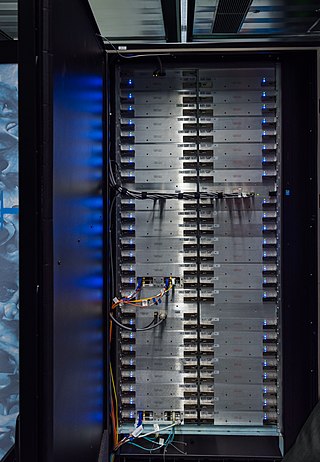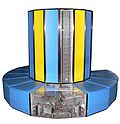Related Research Articles

A supercomputer is a computer with a high level of performance as compared to a general-purpose computer. The performance of a supercomputer is commonly measured in floating-point operations per second (FLOPS) instead of million instructions per second (MIPS). Since 2017, there have existed supercomputers which can perform over 1017 FLOPS (a hundred quadrillion FLOPS, 100 petaFLOPS or 100 PFLOPS).

In computing, floating point operations per second is a measure of computer performance, useful in fields of scientific computations that require floating-point calculations. For such cases, it is a more accurate measure than measuring instructions per second.
Cray Inc., a subsidiary of Hewlett Packard Enterprise, is an American supercomputer manufacturer headquartered in Seattle, Washington. It also manufactures systems for data storage and analytics. Several Cray supercomputer systems are listed in the TOP500, which ranks the most powerful supercomputers in the world.

Roadrunner was a supercomputer built by IBM for the Los Alamos National Laboratory in New Mexico, USA. The US$100-million Roadrunner was designed for a peak performance of 1.7 petaflops. It achieved 1.026 petaflops on May 25, 2008, to become the world's first TOP500 LINPACK sustained 1.0 petaflops system.

The TOP500 project ranks and details the 500 most powerful non-distributed computer systems in the world. The project was started in 1993 and publishes an updated list of the supercomputers twice a year. The first of these updates always coincides with the International Supercomputing Conference in June, and the second is presented at the ACM/IEEE Supercomputing Conference in November. The project aims to provide a reliable basis for tracking and detecting trends in high-performance computing and bases rankings on HPL, a portable implementation of the high-performance LINPACK benchmark written in Fortran for distributed-memory computers.
The National Center for Computational Sciences (NCCS) is a United States Department of Energy (DOE) Leadership Computing Facility that houses the Oak Ridge Leadership Computing Facility (OLCF), a DOE Office of Science User Facility charged with helping researchers solve challenging scientific problems of global interest with a combination of leading high-performance computing (HPC) resources and international expertise in scientific computing.

Jaguar or OLCF-2 was a petascale supercomputer built by Cray at Oak Ridge National Laboratory (ORNL) in Oak Ridge, Tennessee. The massively parallel Jaguar had a peak performance of just over 1,750 teraFLOPS. It had 224,256 x86-based AMD Opteron processor cores, and operated with a version of Linux called the Cray Linux Environment. Jaguar was a Cray XT5 system, a development from the Cray XT4 supercomputer.
The National Institute for Computational Sciences (NICS) is funded by the National Science Foundation and managed by the University of Tennessee. NICS was home to Kraken, the most powerful computer in the world managed by academia. The NICS petascale scientific computing environment is housed at Oak Ridge National Laboratory (ORNL), home to the world's most powerful computing complex. The mission of NICS, a member of the Extreme Science and Engineering Discovery Environment, is to enable the scientific discoveries of researchers nationwide by providing leading-edge computational resources, together with support for their effective use, and leveraging extensive partnership opportunities.

Tianhe-I, Tianhe-1, or TH-1 is a supercomputer capable of an Rmax of 2.5 peta FLOPS. Located at the National Supercomputing Center of Tianjin, China, it was the fastest computer in the world from October 2010 to June 2011 and was one of the few petascale supercomputers in the world.
Exascale computing refers to computing systems capable of calculating at least "1018 IEEE 754 Double Precision (64-bit) operations (multiplications and/or additions) per second (exaFLOPS)"; it is a measure of supercomputer performance.
Kraken was a Cray XT5 supercomputer that entered into full production mode on February 2, 2009. Kraken was operated by the University of Tennessee and was the most powerful computer in the world managed by academia at the time. It was housed in the Oak Ridge Leadership Computing facility at Oak Ridge National Laboratory. Kraken was decommissioned on April 30, 2014.

Several centers for supercomputing exist across Europe, and distributed access to them is coordinated by European initiatives to facilitate high-performance computing. One such initiative, the HPC Europa project, fits within the Distributed European Infrastructure for Supercomputing Applications (DEISA), which was formed in 2002 as a consortium of eleven supercomputing centers from seven European countries. Operating within the CORDIS framework, HPC Europa aims to provide access to supercomputers across Europe.
The Cray XK6 made by Cray is an enhanced version of the Cray XE6 supercomputer, announced in May 2011. The XK6 uses the same "blade" architecture of the XE6, with each XK6 blade comprising four compute "nodes". Each node consists of a 16-core AMD Opteron 6200 processor with 16 or 32 GB of DDR3 RAM and an Nvidia Tesla X2090 GPGPU with 6 GB of GDDR5 RAM, the two connected via PCI Express 2.0. Two Gemini router ASICs are shared between the nodes on a blade, providing a 3-dimensional torus network topology between nodes. This means that it has 576 GB of Graphics memory and over 1500 CPU cores, several orders of magnitude more powerful than the best publicly available computer on the market.

Approaches to supercomputer architecture have taken dramatic turns since the earliest systems were introduced in the 1960s. Early supercomputer architectures pioneered by Seymour Cray relied on compact innovative designs and local parallelism to achieve superior computational peak performance. However, in time the demand for increased computational power ushered in the age of massively parallel systems.

Titan or OLCF-3 was a supercomputer built by Cray at Oak Ridge National Laboratory for use in a variety of science projects. Titan was an upgrade of Jaguar, a previous supercomputer at Oak Ridge, that uses graphics processing units (GPUs) in addition to conventional central processing units (CPUs). Titan was the first such hybrid to perform over 10 petaFLOPS. The upgrade began in October 2011, commenced stability testing in October 2012 and it became available to researchers in early 2013. The initial cost of the upgrade was US$60 million, funded primarily by the United States Department of Energy.

The Cray XC40 is a massively parallel multiprocessor supercomputer manufactured by Cray. It consists of Intel Haswell Xeon processors, with optional Nvidia Tesla or Intel Xeon Phi accelerators, connected together by Cray's proprietary "Aries" interconnect, stored in air-cooled or liquid-cooled cabinets. The XC series supercomputers are available with the Cray DataWarp applications I/O accelerator technology.

Summit or OLCF-4 is a supercomputer developed by IBM for use at Oak Ridge Leadership Computing Facility (OLCF), a facility at the Oak Ridge National Laboratory, capable of 200 petaFLOPS thus making it the 4th fastest supercomputer in the world after Frontier (OLCF-5), Fugaku, and LUMI. It held the number 1 position from November 2018 to June 2020. Its current LINPACK benchmark is clocked at 148.6 petaFLOPS.
The Holland Computing Center, often abbreviated HCC, is the high-performance computing core for the University of Nebraska System. HCC has locations in both the University of Nebraska-Lincoln June and Paul Schorr III Center for Computer Science & Engineering and the University of Nebraska Omaha Peter Kiewit Institute. The center was named after Omaha businessman Richard Holland who donated considerably to the university for the project.

Hewlett Packard Enterprise Frontier, or OLCF-5, is the world's first exascale supercomputer, hosted at the Oak Ridge Leadership Computing Facility (OLCF) in Tennessee, United States and first operational in 2022. It is based on the Cray EX and is the successor to Summit (OLCF-4). As of June 2022, Frontier was the world's fastest supercomputer using AMD CPUs and GPUs. Frontier achieved an Rmax of 1.102 exaFLOPS, which is 1.102 quintillion operations per second. Measured at 62.68 gigaflops/watt, Frontier topped the Green500 list for most efficient supercomputer, until it was dethroned by Flatiron Institute's Henri supercomputer in November 2022.
Aurora is a planned supercomputer to be completed in 2023. It will be the United States' second exascale computer after the AMD-powered Frontier-supercomputer. It is sponsored by the United States Department of Energy (DOE) and designed by Intel and Cray for the Argonne National Laboratory. It will have c. 2 exaFLOPS in computing power which is approximately a quintillion (260 or 1018) calculations per second and will have an expected cost of US$500 million. It will follow Frontier, which was the world's first exascale supercomputer in 2022.
References
- ↑ Schulten, Klaus (November 29, 2012). "Blue Waters petascale supercomputer now in friendly user phase". Outlook Series. Retrieved January 16, 2013.
- 1 2 3 4 5 6 "Cray XK7 Specifications". Cray. Archived from the original on January 6, 2013. Retrieved January 15, 2013.
- ↑ "Introduction to OpenACC and CUDA Programming on the Cray XK7 Platform". Swiss National Supercomputing Centre. January 10, 2013. Retrieved January 15, 2013.
- ↑ Gajus, Brian (December 17, 2012). "Titan Trainers Take Road Trip". Oak Ridge Leadership Computing Facility . Retrieved January 16, 2013.
- ↑ "Cray Launches XK7 Hybrid Super with Titan Debut at ORNL". Inside HPC. October 29, 2012. Retrieved January 15, 2013.
- ↑ "Introducing Titan". Oak Ridge Leadership Computing Facility . Retrieved January 16, 2013.
- ↑ Gajus, Brian (November 12, 2012). "ORNL Supercomputer Named World's Most Powerful". Oak Ridge Leadership Computing Facility . Retrieved January 16, 2013.
- ↑ "November 2012". TOP500 . Retrieved January 15, 2013.
- 1 2 "Heterogeneous Systems Re-Claim Green500 List Dominance". Green500. November 14, 2012. Archived from the original on February 5, 2013. Retrieved January 16, 2013.
- 1 2 "One Year Later: Delivering Sustained Petascale Science" (PDF). National Center for Supercomputing Applications. December 2012. Retrieved January 16, 2013.
- 1 2 "Brief Blue Waters System Summary". National Center for Supercomputing Applications . Retrieved January 16, 2013.
- ↑ "Todi Upgrade to Xk7". Swiss National Supercomputing Centre. October 15, 2012. Archived from the original on February 19, 2013. Retrieved January 16, 2013.
- ↑ "Todi Cray XK7". Swiss National Supercomputing Centre. Archived from the original on January 21, 2013. Retrieved January 16, 2013.
- 1 2 3 "Todi". TOP500 . Retrieved January 16, 2013.
